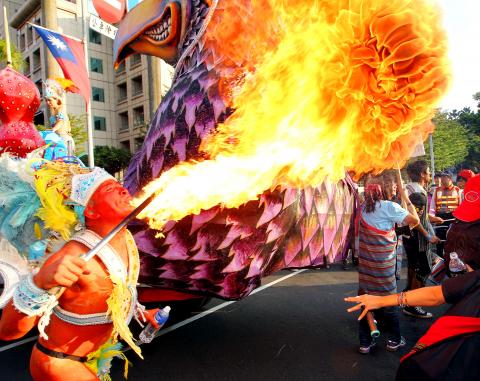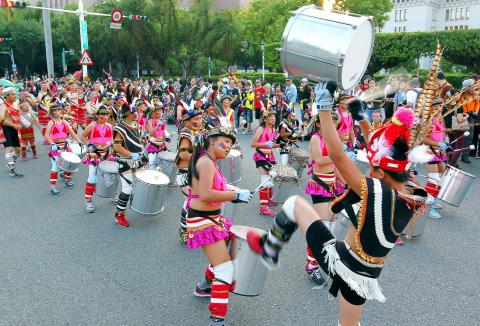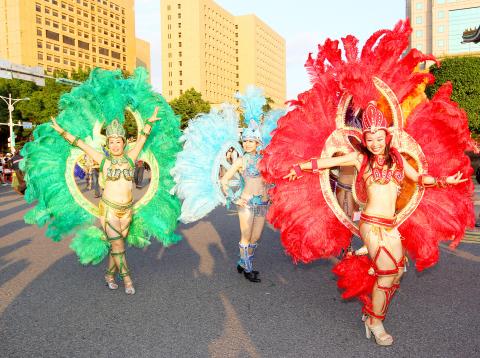It is not often that Taiwanese grandmothers have the chance to outshine teenagers and twenty-somethings, but the “gray mommies,” as Gordon Tsai (蔡聰明) calls them, have definitely become one of the highlights of the Dream Community’s (夢想社區) annual Dream Parade.
The stretch of Taipei from the Chiang Kai-shek Memorial to Katagalan Boulevard (凱達格蘭大道) and the Presidential Office Building is frequently filled with people taking part in political rallies, protests, marches or the annual Double Ten National Day parade/celebration, but for sheer madness and fun it is hard to beat the Dream Parade, whether one is a participant or an observer.
It is a little bit Mardi Gras, a little bit Brazilian carnival and a whole lot of Taiwanese ingenuity.

Photos: CNA
The parades feature elementary and junior-high school samba drumming corps, floats and movable sculptures created by by families, university students and community groups, stilt walkers, samba and belly dancers — whose ages can run from the single digits to octogenarians — and much, much more. The parades are extravaganzas of feathers, sequins, chiffon, beads, glitter, body paint and a whole lot of drumming.
The 14th annual parade will be held on Saturday, and Tsai, the dreamer, prime mover and chairman of the Dream Community in New Taipei City’s Shijr District (汐止) — a lifestyle “village” built on the idea of community-based celebratory art — said this year’s event is an extension of the Matzu project that the community took to the Burning Man festival in Nevada last month.
There is a slightly serious side to the parade. The 20-plus samba drumming teams in the parade come from schools in Aboriginal communities along the east coast and elsewhere around the nation — the result of a years-long project by Tsai, who has sent Brazilian drummers to teach their art as a part of community-building exercises.

Photos: CNA
To get to Taipei each of the teams had to win a local drumming contest, and on Saturday they will be trying to win the National Dream Cup Samba Drum competition, which rewards the top groups with musical instruments and other prizes for their schools. There will be about a dozen judges distributed along the parade route, ranking the youngsters on their drumming, choreography, costumes and energy.
The parade begins at 3pm at the Liberty Plaza between the National Theater and Concert Hall. The 1.2km-long route takes the participants up Zhongshan South Road (中山南路) to Renai Road (仁愛路), where they make a right turn and head toward Linsen South Road (林森南路) and a U-turn that sends them back toward Ketagalan Boulevard and the post-parade party area in front of the Ministry of Foreign Affairs.
The parade is scheduled to end between 6pm and 6:30pm, with an after-party running until 8pm.

Photos: CNA
If you are looking to collect some of the Mardi Gras bead necklaces tossed from the floats, your best chance is to position yourself in front of the Chang Yung-Fa Foundation Evergreen Maritime Museum or at the beginning of Renai Road, where the crowds tend to be a bit thinner than the initial stretch of Zhongshan. Those are also the best places to be to take photographs.

May 11 to May 18 The original Taichung Railway Station was long thought to have been completely razed. Opening on May 15, 1905, the one-story wooden structure soon outgrew its purpose and was replaced in 1917 by a grandiose, Western-style station. During construction on the third-generation station in 2017, workers discovered the service pit for the original station’s locomotive depot. A year later, a small wooden building on site was determined by historians to be the first stationmaster’s office, built around 1908. With these findings, the Taichung Railway Station Cultural Park now boasts that it has

The latest Formosa poll released at the end of last month shows confidence in President William Lai (賴清德) plunged 8.1 percent, while satisfaction with the Lai administration fared worse with a drop of 8.5 percent. Those lacking confidence in Lai jumped by 6 percent and dissatisfaction in his administration spiked up 6.7 percent. Confidence in Lai is still strong at 48.6 percent, compared to 43 percent lacking confidence — but this is his worst result overall since he took office. For the first time, dissatisfaction with his administration surpassed satisfaction, 47.3 to 47.1 percent. Though statistically a tie, for most

Six weeks before I embarked on a research mission in Kyoto, I was sitting alone at a bar counter in Melbourne. Next to me, a woman was bragging loudly to a friend: She, too, was heading to Kyoto, I quickly discerned. Except her trip was in four months. And she’d just pulled an all-nighter booking restaurant reservations. As I snooped on the conversation, I broke out in a sweat, panicking because I’d yet to secure a single table. Then I remembered: Eating well in Japan is absolutely not something to lose sleep over. It’s true that the best-known institutions book up faster

In February of this year the Taipei Times reported on the visit of Lienchiang County Commissioner Wang Chung-ming (王忠銘) of the Chinese Nationalist Party (KMT) and a delegation to a lantern festival in Fuzhou’s Mawei District in Fujian Province. “Today, Mawei and Matsu jointly marked the lantern festival,” Wang was quoted as saying, adding that both sides “being of one people,” is a cause for joy. Wang was passing around a common claim of officials of the People’s Republic of China (PRC) and the PRC’s allies and supporters in Taiwan — KMT and the Taiwan People’s Party — and elsewhere: Taiwan and